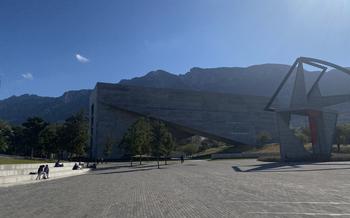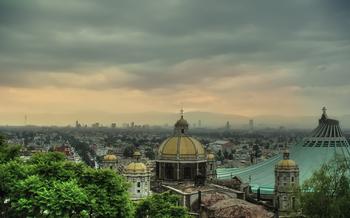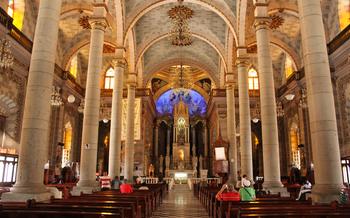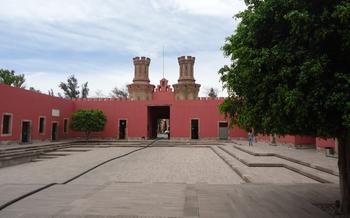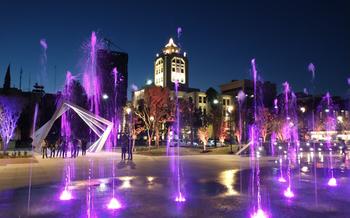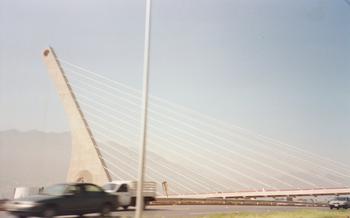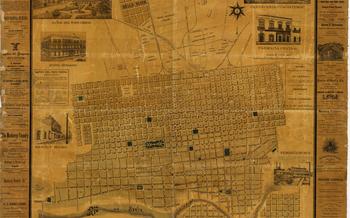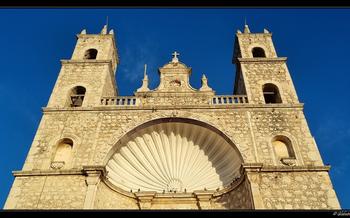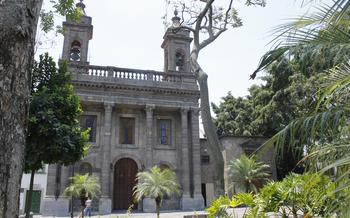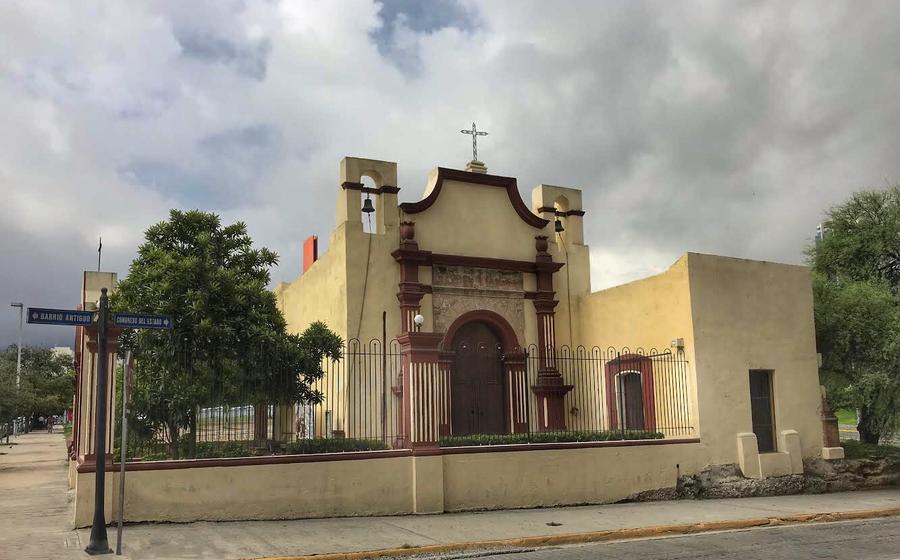
Capilla de los Dulces Nombres
- Capilla de los Dulces Nombres: A Hidden Gem in Monterrey
- Location and Accessibility
- Visiting Hours and Admission
- Exploring the Chapel's Exterior
- Stepping Inside the Chapel
- The Capilla's Historical Significance
- Cultural and Religious Events
- Pilgrimages and Devotion
- Artistic and Architectural Treasures
- Photography and Documentation
- Local Cuisine and Flavors
- Shopping and Souvenirs
- Nearby Attractions and Activities
- Practical Tips for Visitors
- Insider Tip: Hidden Gems Nearby
Capilla de los Dulces Nombres: A Hidden Gem in Monterrey
In the heart of Monterrey, nestled amid bustling streets and modern skyscrapers, lies a hidden gem that transports visitors back in time – the Capilla de los Dulces Nombres. This charming chapel, with its intricate architecture and profound religious significance, stands as a testament to the city's rich history and enduring faith. Built in the 18th century, the chapel has borne witness to Monterrey's transformation from a small colonial town to a vibrant metropolis. Its enduring presence serves as a reminder of the city's deep-rooted Catholic heritage and the enduring power of faith in the lives of its people.
The Capilla de los Dulces Nombres is a stunning example of Baroque architecture, characterized by its ornate facade, intricate carvings, and graceful curves. The exterior of the chapel is adorned with sculptures of saints and angels, each with a unique story to tell. The interior of the chapel is equally impressive, with its beautifully painted walls, intricate altarpieces, and stained glass windows that cast a warm and ethereal glow.
Beyond its architectural beauty, the Capilla de los Dulces Nombres holds deep religious significance for the people of Monterrey. Dedicated to the Virgin Mary under the title of Our Lady of the Sweet Names, the chapel has been a place of pilgrimage and devotion for centuries. Believers from all walks of life come to the chapel to seek solace, offer prayers, and pay homage to the Virgin Mary. The chapel's reputation for miracles and answered prayers has further cemented its status as a sacred site, drawing visitors from far and wide.
Location and Accessibility
The Capilla de los Dulces Nombres is situated in the heart of Monterrey, at Calle Zaragoza 1200, in the Barrio Antiguo neighborhood. This historic district is easily accessible by various means of public transportation. The Alameda metro station, served by Line 2, is just a short walk from the chapel. Several bus lines also stop nearby, including routes 1, 3, 18, and 2For those arriving by car, limited street parking is available in the surrounding area. The chapel is wheelchair accessible, with ramps and elevators providing easy access to all levels.
Visiting Hours and Admission
The Capilla de los Dulces Nombres welcomes visitors with open doors during specific hours each day. The regular hours of operation are typically from 8:00 AM to 5:00 PM, seven days a week. However, it's always advisable to check with the chapel authorities or visit their official website for any updates or changes to the schedule. Special hours may be observed for religious services, such as masses or prayer sessions.
Admission to the chapel is generally free of charge. Donations are welcome and appreciated, as they contribute to the upkeep and preservation of this sacred space. Guided tours are not regularly offered, but visitors can explore the chapel at their own pace and immerse themselves in its serene atmosphere.
Before entering the chapel, remember to be respectful and mindful of the sacred nature of the site. Dress appropriately and maintain silence while inside to not disturb ongoing religious activities or the contemplative moments of other visitors.
Exploring the Chapel's Exterior
The Capilla de los Dulces Nombres boasts an impressive facade that reflects the architectural style of the 18th century. The Baroque influences are evident in the intricate carvings and sculptures adorning the entrance. The yellow cantera stone facade is a testament to the region's rich architectural heritage.
The main entrance features a majestic arched doorway, flanked by two ornate columns. The stone carvings above the arch depict scenes from the Bible, adding a touch of religious significance to the structure. The intricate designs on the columns and capitals showcase the skill and artistry of the craftsmen who built this chapel.
One of the most striking features of the facade is the bell tower. Rising high above the entrance, the tower features a series of arched openings and is topped with a domed roof. The iron cross atop the dome serves as a symbol of the chapel's religious purpose.
The side walls of the chapel are adorned with pilasters and cornices, adding depth and dimension to the exterior. Niches containing statues of saints add a touch of spirituality and create a serene ambiance. The overall effect of the chapel's facade is one of grandeur and devotion, inviting visitors to step inside and explore its sacred interior.
Stepping Inside the Chapel
As you step through the arched doorway of the Capilla de los Dulces Nombres, a sense of awe and tranquility envelops you. The interior of the chapel is a testament to the artistry and devotion of its creators. The layout is simple yet elegant, with a central nave leading to the altar. The altar itself is a masterpiece of Baroque craftsmanship, adorned with intricate carvings, gold leaf, and a stunning altarpiece depicting scenes from the life of Christ.
The stained glass windows that adorn the chapel's walls are equally impressive. These windows, crafted by skilled artisans, depict various biblical scenes and religious figures. The vibrant colors and intricate details of the windows create a magical atmosphere, filtering the sunlight into a kaleidoscope of hues that dance across the chapel's interior.
The symbolism and iconography present throughout the chapel's interior are profound and thought-provoking. Every detail, from the carvings on the pews to the frescoes on the walls, holds a deeper meaning, inviting visitors to contemplate the mysteries of faith and the life of Christ.
Compared to other religious interiors in Mexico, the Capilla de los Dulces Nombres stands out for its intimate atmosphere and its focus on intricate details. While other churches may be larger and more elaborate, the Capilla de los Dulces Nombres offers a more personal and contemplative experience, allowing visitors to connect with the divine in a profound and meaningful way.
The Capilla's Historical Significance
The Capilla de los Dulces Nombres holds a significant place in the history of Monterrey. Built in the 18th century, it stands as a testament to the city's religious heritage and cultural development. The chapel served as a central hub for religious ceremonies and community gatherings, playing a crucial role in shaping the spiritual and social fabric of Monterrey.
Its enduring presence has made it a cultural and architectural landmark, attracting visitors from near and far. The chapel's unique blend of Baroque and Neoclassical styles showcases the city's rich artistic legacy and reflects the broader architectural trends of the era. Moreover, its well-preserved condition contributes to its historical significance, allowing visitors to step back in time and experience the grandeur of colonial Mexico.
The chapel's historical importance is further underscored by the efforts made to preserve and restore it. Restoration projects have been meticulously undertaken to maintain its structural integrity while preserving its original features and charm. These efforts demonstrate the deep appreciation and respect for the chapel's heritage, ensuring its legacy continues to inspire future generations.
Cultural and Religious Events
The Capilla de los Dulces Nombres is not just a historical and architectural landmark but also a vibrant center of religious and cultural activities. Regular religious services are held in the chapel, allowing visitors to witness the devotion and traditions of the local Catholic community. During special events and festivals, the chapel transforms into a hub of celebration, with processions, music, and colorful decorations filling the air.
One of the most significant events is the annual feast of the Dulces Nombres, held on August 7th. During this festival, the chapel becomes a pilgrimage site for thousands of devotees who come to pay homage to the Virgin Mary and seek her blessings. The festivities include processions, masses, and traditional music performances, creating a lively and joyous atmosphere.
Another important event is the Holy Week, during which the chapel hosts special services and processions commemorating the Passion and Resurrection of Jesus Christ. These events are deeply rooted in Mexican culture and provide a unique opportunity for visitors to experience the rich religious traditions of the country.
Pilgrimages and Devotion
The Capilla de los Dulces Nombres holds a profound significance as a pilgrimage site for the devout. Pilgrims from all corners of Mexico and beyond flock to the chapel to pay homage to the Virgin Mary and seek her blessings. The chapel's reputation for miracles and answered prayers has drawn countless individuals who come with hearts filled with faith and hope.
One of the most compelling reasons why people visit the chapel for devotion is the belief that the Virgin Mary has a special connection to this sacred place. Many pilgrims share stories of how their prayers were answered after visiting the chapel, or how they experienced a sense of peace and tranquility within its walls. The chapel has become a sanctuary for those seeking comfort, guidance, and spiritual renewal.
Over the years, numerous legends and stories have emerged surrounding the Capilla de los Dulces Nombres, further solidifying its status as a pilgrimage site. These stories often speak of miraculous events, healings, and divine interventions that have occurred within the chapel. The local community holds these legends dear, as they serve as a testament to the enduring power of faith and the enduring presence of the Virgin Mary in their lives.
The chapel's significance as a pilgrimage site has had a profound impact on the local community. The influx of pilgrims has helped to sustain the chapel's upkeep and preservation, ensuring that it remains a beacon of hope and devotion for generations to come. Additionally, the presence of pilgrims has fostered a sense of unity and camaraderie among the local residents, who come together to welcome and assist the visitors who seek solace and inspiration within the chapel's sacred walls.
Artistic and Architectural Treasures
The Capilla de los Dulces Nombres is a treasure trove of artistic and architectural masterpieces that captivate the eyes and souls of visitors. The chapel's interior is adorned with exquisite artwork and sculptures, each piece carefully crafted by skilled artisans using various techniques and styles. The walls and ceiling are adorned with intricate murals depicting biblical scenes and the lives of saints, while the altar features a stunning altarpiece with intricate carvings and gilded details.
One of the highlights of the chapel is the collection of stained glass windows that illuminate the interior with vibrant colors. These windows depict various religious figures and scenes, casting an ethereal glow that adds to the chapel's mystical ambiance. The symbolism and themes depicted in the artwork are deeply rooted in Catholic tradition and serve as a reminder of the chapel's religious significance.
The chapel's artistic and architectural elements are not only aesthetically pleasing but also hold profound religious and cultural meaning. They reflect the deep faith and devotion of the people of Monterrey and serve as a testament to the city's rich artistic and cultural heritage. Visitors are encouraged to take their time to admire the intricate details and symbolism of the artwork, allowing themselves to be transported back in time to a world of faith, devotion, and artistic mastery.
Photography and Documentation
When visiting the Capilla de los Dulces Nombres, it is important to be respectful of the sacred nature of the site. Visitors are permitted to take photos and videos, but they should do so discreetly and without disturbing others who are praying or worshipping. Using a flash or tripod is not allowed, as it may disrupt the ambiance and sanctity of the chapel.
It is also essential to capture the essence of the chapel through photography. The stunning architecture, intricate carvings, and colorful stained glass windows make for beautiful and inspiring subjects. By capturing these details, visitors can preserve their memories of the chapel and share them with others who may not have the opportunity to visit.
Photographers should be mindful of the composition of their shots, ensuring that they capture the grandeur and beauty of the chapel. They should also consider the lighting conditions, as the natural light streaming through the windows can create dramatic effects.
Sharing images and experiences of the Capilla de los Dulces Nombres with others can help to raise awareness of this hidden gem and encourage others to visit. By sharing their photos and stories, visitors can contribute to the preservation and appreciation of this important cultural and religious landmark.
Local Cuisine and Flavors
After exploring the Capilla de los Dulces Nombres, take a culinary journey into Monterrey's vibrant food scene. The area surrounding the chapel offers a diverse range of restaurants and cafes, each offering a taste of the city's rich culinary heritage.
For a traditional Mexican experience, try Restaurante El Mirador, known for its mouthwatering barbacoa and flavorful moles. Alternatively, head to La Catarina, a charming eatery that serves up contemporary Mexican cuisine with a modern twist.
For a quick bite, stop by La Antigua Dulceria, a local institution that has been serving traditional Mexican sweets and pastries since 189Indulge in their famous glorias, a sweet pastry filled with cajeta, or try their refreshing aguas frescas, made with fresh fruit and natural flavors.
To enjoy a meal with a view, visit one of the many rooftop restaurants in the area. Restaurante La Torre offers panoramic views of the city skyline, while La Terraza del Hotel Monterrey provides a stunning backdrop of the Capilla de los Dulces Nombres.
Whether you're craving traditional Mexican dishes, modern culinary creations, or simply a sweet treat, the area surrounding the Capilla de los Dulces Nombres offers something to satisfy every palate.
Shopping and Souvenirs
After your visit to the Capilla de los Dulces Nombres, you might want to take home a souvenir to remember your experience. There are several shops and boutiques in the surrounding area that sell religious items and souvenirs. You can find everything from traditional rosaries and crucifixes to unique pieces of art and jewelry.
For those interested in local crafts and handmade goods, there are several shops that sell items such as pottery, textiles, and woodwork. These make for unique gifts and mementos to take home. By purchasing from these shops, you'll also be supporting the local economy and helping to preserve traditional Mexican crafts.
Nearby Attractions and Activities
The Capilla de los Dulces Nombres is situated in the heart of Monterrey, a city brimming with cultural and historical treasures. Take advantage of your visit to the chapel to explore other fascinating attractions in the vicinity.
The Museo de Arte Contemporáneo de Monterrey (MARCO) is a must-see for art enthusiasts, showcasing modern and contemporary works from local and international artists. For a glimpse into the city's rich history, visit the Museo de Historia Mexicana, housing artifacts and exhibits that narrate Monterrey's captivating past.
To experience the vibrant local culture, head to the Barrio Antiguo, Monterrey's oldest neighborhood. Wander through its charming streets lined with colorful buildings, art galleries, and traditional Mexican restaurants. Don't miss the opportunity to sample the city's culinary delights at one of the many renowned restaurants offering mouthwatering regional dishes.
For a breath of fresh air, escape to the Parque Fundidora, a sprawling urban park built on the grounds of a former steel factory. Explore its tranquil gardens, admire the impressive architecture, and enjoy recreational activities such as biking, jogging, or simply relaxing by the lake.
With so much to see and do in Monterrey, customize your itinerary to suit your interests and make the most of your visit. From historical landmarks to modern cultural hubs, the city offers an array of experiences that will leave you captivated.
Practical Tips for Visitors
When visiting the Capilla de los Dulces Nombres, it is important to be mindful of local customs and traditions. Dress modestly and respectfully, covering your shoulders and knees. Be quiet and reverent inside the chapel, and avoid talking or taking photos during religious services.
Take common sense safety precautions, such as being aware of your surroundings and keeping your valuables secure. It is generally safe to walk around the area during the day, but it is advisable to be cautious at night.
To communicate effectively with locals, it is helpful to learn a few basic Spanish phrases. Many people in Monterrey speak English, but it is always appreciated when visitors make an effort to speak the local language.
By following these practical tips, you can ensure a safe and enjoyable visit to the Capilla de los Dulces Nombres.
Insider Tip: Hidden Gems Nearby
While exploring Monterrey, venture beyond the Capilla de los Dulces Nombres to discover hidden gems that often go unnoticed by tourists. Immerse yourself in the vibrant local culture by visiting traditional markets, such as Mercado Pino Suárez, where you can savor authentic Mexican cuisine and find unique souvenirs. Explore the nearby Barrio Antiguo, the oldest neighborhood in Monterrey, with its charming cobblestone streets, colorful buildings, and historic landmarks. Take a stroll through the Paseo Santa Lucía, a picturesque river walk lined with restaurants, cafes, and shops, offering stunning views of the city skyline. For a unique culinary experience, try the street food stalls in the city center, where you can indulge in delicious local delicacies like tacos, tortas, and fresh fruit juices. Uncover the hidden treasures of Monterrey by venturing off the beaten path and embracing the city's rich cultural tapestry.

